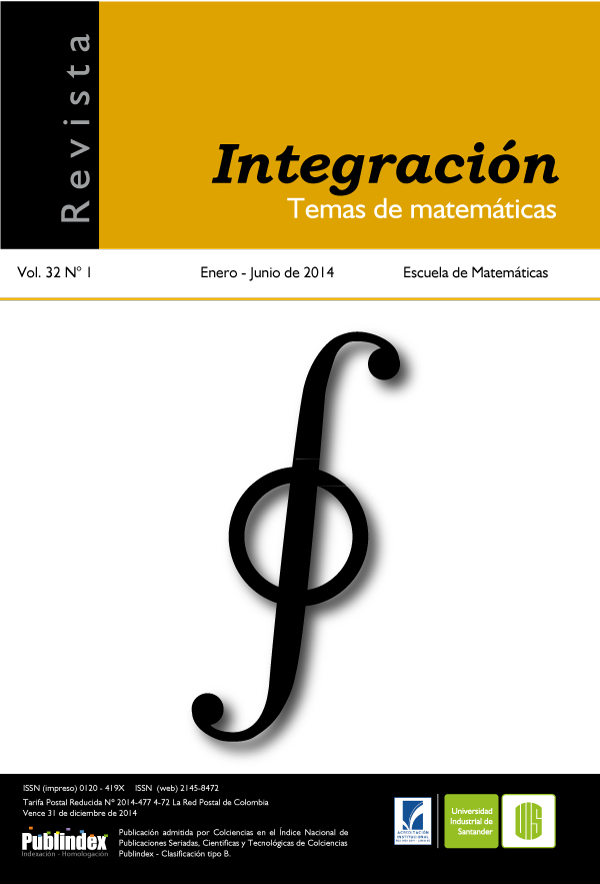Published 2014-05-22
Keywords
- Linear logic,
- monoidal categories,
- enriched categories,
- categorical semantic.
How to Cite
Abstract
Categorical semantics have established formal and accurately the meaning of the terms and connectives of different logics. In particular, the work of various authors, starting with de Paiva and Hyland [3], have allowed to look at the semantics of linear logic, both classical and intuitionists, from a categorical point of view. One of the most important task is to try to give a categorical interpretation to the exponential operator !. Mellies [11] and Bierman [4] have finally shown that this interpretation corresponds to a composition between monoidal adjoints. With the emergence of SELL, now we have a family of subexponential, adjusted within a preorder structure. The intention in this work is to obtain a categorical interpretation for this family of subexponentials, inspired by the very notion of monoidal adjoints, but preserving the preorder structure assigned to the exponential family.
To cite this article: C. E. Ramírez, Semántica categórica para subexponenciales en SELL, Rev. Integr. Temas Mat. 32 (2014), no. 1, 39–54.
Downloads
References
- Andreoli J.-M., “Logic Programming with Focusing Proofs in Linear Logic”, J. of Logic and Computation 2 (1992), no. 3, 297–347.
- Benton P.N., A mixed linear and non-linear logic: proofs, terms and models, Proceedings of Computer Scienca Logic 94, Springer Verlag, LNCS 933, 1994.
- Benton P.N., Bierman G.M., de Paiva V.C.V., Hyland J.M.E., Term assignment for intuitionist linear logic, Technical Report 262, Computer Laboratory, University of Cambridge,
- Bierman G., On intuitionist linear logic, Thesis (Ph.D.), University of Cambridge, 1994.
- Danos V., Joinet J.-B. and Schellinx H., The Structure of Exponentials: Uncovering the Dynamics of Linear Logic Proofs, In Georg Gottlob, Alexander Leitsch and Daniele Mundici,
- editeurs, Kurt Gödel Colloquium, 713 of LNCS, p. 159-171. Springer, 1993.
- Girard J.-Y., “Linear logic”, Theoretical Computer Science 50 (1987), 1–102.
- Kelly M., Basic concepts of enriched category theory, volume 64 of LMS, Lecture Notes. Cambridge University Press, 1982.
- Kelly M., “Doctrinal adjuntion”, Lecture Notes in Math. 420 (1974), 257–280.
- Lafont Y., Logiques, catégories et machines, Ph.D. Thesis, Université Paris 7, 1988.
- Mac Lane S., Categories for the Working Mathematician, Springer Verlag, 1971.
- Melliès P.-A., Categorical Semantics of Linear Logic, Panoramas et Synthèses 27, Société Mathématique de France, 2009.
- Melliès P.-A., Categorical semantics of linear logic, Interactive models of computation and program behaviour, Société Mathématique de France, 2009.
- Nigam V., Exploiting non-canonicity in the sequent calculus, Thesis (Ph.D.), Ecole Polytechnique, 2009.
- Nigam V. and Miller D., Algorithmic specifications in linear logic with subexponentials, In ACM SIG1015 PLAN Conference on Principles and Practice of Declarative Programming (PPDP), 129–140, 2009.
- Pimentel E., Nigam V. and Reis G., An Extended Framework for Specifying and Reasoning about Proof Systems, submitted to Logical Journal of the IGPL, (2012), p. 37.
- Seely R., Linear logic, *-autonomous categories and cofree coalgebras, Applications of categories in logic and computer science, Contemporary Mathematics 92, 1989.
